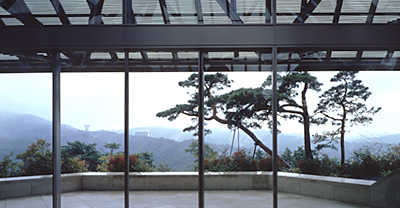
![]()
| After passing through a peach orchard in full, brilliant bloom and then through a cave, you happen upon the hidden paradise of Toh Gen Kyo. If you were charged with creating Toh Gen Kyo, what details of its design would you give particular care to? | |||
| For I. M. Pei, the road approaching the Miho Museum held particular importance. Construction of the tunnel between the peach trees lined road and the half-suspension bridge that leads to the Museum's main entrance began six months after people started saying that it never would be completed in time for the Miho's opening. When the project was finally launched, a detailed building plan arrived from Mr. Pei's office in New York City. Seeing it for the first time, the construction company was stunned. Up till that point, a short tunnel had been decided upon for the Museum's approach. However, the freshly drawn plans called for a much longer tunnel than anticipated and one that curved through a wide expanse of mountain so as not to allow a view of the Museum's facade on the other side from its entrance. |  |
||
| Despite this, construction
went ahead and eventually everyone understood what Pei had in mind,
and after passing through the tunnel, you will too. Progressing
through the tunnel, the exit is announced with a flood of sunlight.
Going further, the first glimpse of the Museum's roofline dramatically
emerges in the full light of day. It appears like a private residence,
beckoning its visitors, somewhat like a scene painted on a Japanese
folding fan. After feeling the winds through the silver cables of the suspension bridge that connects the tunnel to the museum as you cross it, you pass through the entrance and find yourself under the building's roof. In front of you, a large wall of glass unfolds to reveal a wide expanse of the surrounding pine-covered mountains. When Pei stood on this mountain before he set down the design for the Museum, he made a series of footings, each 5 meters higher than the last. This allowed him to choose the best place to see the ridgeline of the mountains in front of him. With this extraordinary view in mind, the entire structure was planned. The very first time he stood on the mountain, Pei was looking through the windows that he would later design. But he knew that one thing more was set needed to make the landscape complete, a natural screen of pine trees. This led to the planting of a pine trees some 180 years old on the entrance veranda. And there was no other option at that point but to position the tunnel so that the first view of the Museum would appear as it does. |
|||
